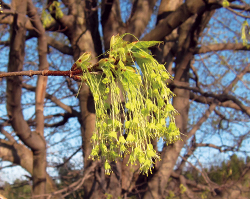Field Notes: Flowers in the Sky

The slope I’m on is steep and there’s no room between the guardrail and the pitch downward to have both feet on the ground at once. Those occasionally driving by on this narrow country road are probably wondering what I’m doing in such a precarious situation. But golly, it’s spring and I’m enthusiastic!
Finally, I’m able to hold onto a tree and pull out my camera. Gazing down into the valley, I see an attractive mottling of muted browns and greys, punctuated by softly vibrant clusters of pale, but striking, yellow flowers. These localized hazy yellow splotches are not on the ground, but adorning the forest canopy, for this is mid-April and the sugar maple trees are in full bloom. Their glimmering presence against the surrounding darker landscape exhibits the quality of an impressionist’s painting.
I take a deep, cool breath of spring air. I am in the glory of the day and in the display of the sugar maple, one of my favorite trees (if naturalists are permitted to have favorites). Not only have I made delectable syrup from its sap and enjoyed its radiant oranges and yellows in autumn, but I do also revel in years when their bloom is impressive. Look, up and down the valley there are groves and scattered individual yellow trees, some mixing in with the only green – the hemlocks.
Holding on to the trusted sapling (a black birch), I lean out over the valley side far enough to glimpse a side gulley where a tributary stream creates cooler and moister conditions. At that location is a particular density of sugar maples, showing me that they favor that setting. I’m reminded that being able to distinguish individual species of trees in the spring or autumn is a way to differentiate sub-habitats in the larger forested landscape, which later on will be a more confusing mass of similar shades of summer’s green.
Because the sugar maple is fond of rich, neutral-to-basic soils, the yellow clusters also show where microhabitats are found that often support select associated species. For example, these are often good spots to seek out a diversity of the ground-hugging, ephemeral wildflowers that are often our fancy in spring: trilliums, violets, phlox and many more. In this west-to-east flowing valley of Little Buffalo Creek, the yellow is on the north-facing side, not the drier more acidic opposite slope where oaks dominate. I know where there is an open-grown sugar maple with low limbs and I set off to see if it is blooming so that I can get closer to some of the flowers.
By now, the sun is out full and there is a slight breeze wafting. Indeed, it is a vigorously fertile tree this year. I find the flowers as intriguing up close as they were from a distance. The male flowers are the most obvious and they are dangling on dainty threadlike strings. The little flowers at the ends all move to one side with a puff of wind. The soft color of the individual clusters is now rather stark when up close against a backdrop of sky blue.
I feel some angst in thinking that others are going about the day oblivious to this wildflower. I want to find someone, tap them on the shoulder and say, “Hey, do you see those gorgeous sugar maples over there?” So, I will have to be satisfied that perhaps you will keep your eyes searching for this treasure.
Charles Bier is the senior conservation scientist for the Western Pennsylvania Conservancy.
